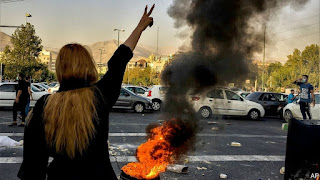Iranians Raging on the Streets Again
Photo source: The Economist
By Naveed Qazi | Editor, Globe Upfront
After the death in custody of Mahsa Amini, a young Kurd, who died in a coma, with skull injuries on a ventilator, for ‘inappropriate dress’ by the moral police in September, 2022, the intellectual assertions of George Orwell become fitting for Iran’s new protest movement. He believed that revolutions didn’t come by chance, but by reason and that revolutionaries of the past become new tyrants, only to be toppled again. Iran’s foundations as a theocracy seem wobbling because this is not the first time in recent memory that Iranians are at odds with their leaders.
In 2009, millions of adults took to the street over alleged fraud in the presidential election. It was called the Green Movement, which was largely urban and middle class. At that time, they rallied around two losing candidates, waved massive banners demanding democracy, and women wore headscarves, sashes, and paint in a vivid shade of green. As a counter-reaction, hundreds were convicted in Stalinesque mass trials back then. Protests erupted again over the price of eggs and poultry, in 2017, and over price hikes for gas, in 2018. Then, 2019 was also a massive year for dissent which was snubbed violently. The demonstrations in 2022 are rawer, centred largely on school and university campuses with street bonfires where girls and women are cutting their hair and taking off and burning their hijabs. The movement is, so far, largely leaderless. Press with its photographs and videos have broadcasted soul-crushing scenes, as protesters know only what they are against. ‘Death to the dictator’ and ‘Mullahs get lost’ have been popular slurs targeting the Supreme Leader, Ayatollah Ali Khamenei.
Men and boys have joined in as well, reflecting that they too are unhappy with the system, and need an alternative. According to Daniel Edelstein, a political scientist, one of the few possible parallels to this revolution was the role of Parisian female poissonieres, or market workers, who stormed Versailles to prevent the king from turning against the National Assembly and crushing the nascent French Revolution. But, what makes this revolution unique is that the upheaval is about women’s freedom, and that’s what makes it special as well. This event is also something similar to bread riots led by women in Petrograd during the tsarist empire collapse.
Men and boys have joined in as well, reflecting that they too are unhappy with the system, and need an alternative. According to Daniel Edelstein, a political scientist, one of the few possible parallels to this revolution was the role of Parisian female poissonieres, or market workers, who stormed Versailles to prevent the king from turning against the National Assembly and crushing the nascent French Revolution. But, what makes this revolution unique is that the upheaval is about women’s freedom, and that’s what makes it special as well. This event is also something similar to bread riots led by women in Petrograd during the tsarist empire collapse.
The state murder of Amini has unusually gotten more press attention than previous cases which refused to make headlines.
What is worrying for the Iranian grey-bearded theocrats is that people, including children who have died, will provide a stimulus for more protests, as in Shiite Islam, deaths are commemorated again after forty days, which will also provide newer confrontations with the police, giving rise to more causalities. The likelihood of new funerals will provide a similar background that generated the rhythm of Iran’s Revolution in 1978 that prompted the Shah to flee in 1979. Hence, the protestors are intensifying domestic woes, at a time when US sanctions have tanked Tehran’s currency and limited its oil exports.
According to Robin Wright’s New Yorker Oped, ‘Iran’s revolutionaries planted the seeds of their own unravelling.’ It is because the feminist movement in Iran is strong as they make up the majority of the university system, yet they are underrepresented in the labour force. The protests are also happening at a looming transition which might happen in the guardian council leadership soon, as the current supreme leader is ill and battling prostate issues.
Pondering on the leadership crises in the guardian council, to calm down the flaring moods, it likely led Ebrahim Raisi to render a public apology to the people, where he admitted to certain ‘weaknesses’ and ‘shortcomings’ in the political system. It might sound cynical at the same time because he has employed counter-demonstrators in universities wearing black chadors, and clamped down Internet access as well.
The protest seems reminiscent of an old idea: let the will of common Iranians be reflected in the political system. But, outsiders cannot help much.
As hardliners try to have a grip on every aspect of social life, the feminist movement has grown even more strong. It can be ascertained with an example of International Women’s Day in March 2019, when several women activists in Tehran took their hijab off on the subway and handed out flowers to each other.
It is also believed by commoners that Raisi has tried to instigate more fear among women. In 2022, he ordered a new Hijab and Chastity law, in which women who posted pictures without the hijab online would be deprived of some social rights for six months to one year. The reason for it is that hijab-wearing women symbolically represent the continuation of the Islamic republic. Once that is gone, it will be hard for the clergy junta to improvise power in future.




Comments
Post a Comment
Advice from the Editor: Please refrain from slander, defamation or any kind of libel in the comments section.